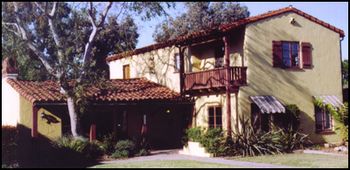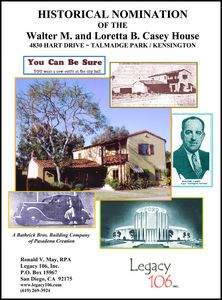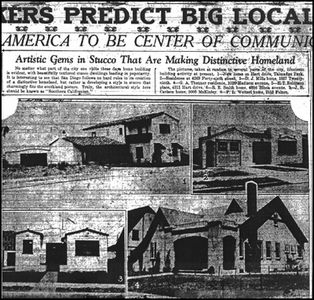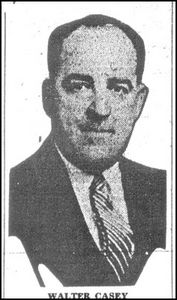|
|
 |
|
|
Historic Landmark No. 668 Talmadge Park Unit 2 Community Historical Landmark No. 668 - Designated June 2004 |
|
|
| ||
|
|
A Bathrick Bros. Building Company of Pasadena Creation This historic 1929, two-story, Spanish Eclectic, Monterrey style house in the Kensington community of Talmadge Park was built by the well-reputed Pasadena-based Bathrick Brothers Building Company, who built the house on speculation in 1929 as they worked on a number of other custom homes in nearby Kensington Manor. The house quickly sold to a succession of speculators and several editions of the Sunday San Diego Union featured promotional photos of it until Loretta and Walter Casey bought it for their residence in September 1929, just before the great stock market crash devastated lives across the nation. The three Bathrick brothers of Bathrick Bros. Building Company of Pasadena came to San Diego in the late 1920s to purchase lots in Kensington to develop their superior custom homes that had been so popular in the greater Los Angeles area. | |
|
|
The house is also directly associated with Walter Casey, an important local person who involved himself in San Diego’s city politics and business during the mid 1930s. Casey was a successful San Diego businessman and civic leader who owned a well-respected Ford dealership in San Diego. An avid believer in individual participation in community affairs, Casey successfully convinced the Ford Motor Co. to participate in the 1935-36 exposition when San Diego’s corrupt city politics threatened to keep them away. To do that, Casey had to convince Ford that San Diego was not a hotbed of corruption. Casey co-founded the upstart Civic Affairs Conference to clean up San Diego’s city politics. | ||
|
|
Casey and his colleagues held conference meetings around San Diego community centers, restaurants, and homes to establish a political platform for their four candidates. To break the big boss political control of the city council, they wrote a new charter that reshaped City Hall to a powerful city manager form of government. Both the charter amendment and Civic Affairs Conference candidates carried in the elections. The “supreme powers” formerly held by the mayor terminated with the charter amendment and the CAC slate assumed control of the council, much to the chagrin of the old power structure. They put a new outfit in city hall and perhaps more importantly, shifted power to include a City Manager in the decision-making process, a change that remains a hotbed of controversy even to the present day. | ||
|
|
Permission to use this material is granted provided it is attributed as follows: Copyright © 2005 Ronald V. May and Dale Ballou May, Legacy 106, Inc., www.legacy106.com | |
|
|
Home | Designations | Qualifications | Company Profile | Newsletter | Links Archaeology
& Historic Preservation www.legacy106.com |
|





